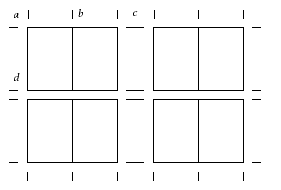The n-Up Pages and Step And Repeat functions use smart crop marks. These are marks intended to show where to trim or fold the printed sheet. We call them smart marks because they never overlap a page, and convert to fold marks when then need to.
This diagram shows some (exaggerated) marks.

You can see normal crop marks in each corner, for instance at a. There are also normal crop marks running down the central gap, though the marks overlap each other, for instance at c.
At b there is no room for the horizontal part of the marks because they would overlap the tops of the adjoining pages, so only the vertical part appears, as a fold mark.
At d the pages don't touch but they are too close to allow the vertical parts of the mark to be used.
Notes
on smart crop marks
1.
The
crop mark size and style can be changed for n-Up Pages and Step And
Repeat using the Custom
crop marks button.
2. The default dimensions of marks are as follows. Marks start 10 points (0.14 inches, 3.5 mm) from the edge of a page, and are 20 points (0.28 inches, 7.1 mm) long. Marks will never be placed if any part of them would be less than 10 points from a page. This implies that if you want default-sized marks to appear between a row or column of pages the spacing must be at least 40 points (0.56 inches, 14.2 mm).
3.
When
performing colour separation, the choice of plates containing the crop marks is
important. Crop marks may be defined on the black plate only, the CMYK plate,
or all plates. You can choose which, by using Imposition Preferences .
5. The bleed area of a page is
allowed to overlap crop marks. The exclusion only applies to the area within
the bleed (bleed interior). See Tile pages .
6. Crop marks can be removed,
but only from an entire sheet, with the Peel Off Registration Marks function.
Crop mark enhancements (6.0)
Crop marks now have an option to set a white background (in custom crop mark set up). This is useful when the crop marks need to contrast with an existing background. This also applies to crop marks in Manual Imposition and Create Booklet.
The colour is “almost white”, in fact 1% white. This is chosen to avoid issues where whites may disappear if overprinted. The background thickness is the same as the mark thickness.
Peel Off Crop Marks also peels off any background.